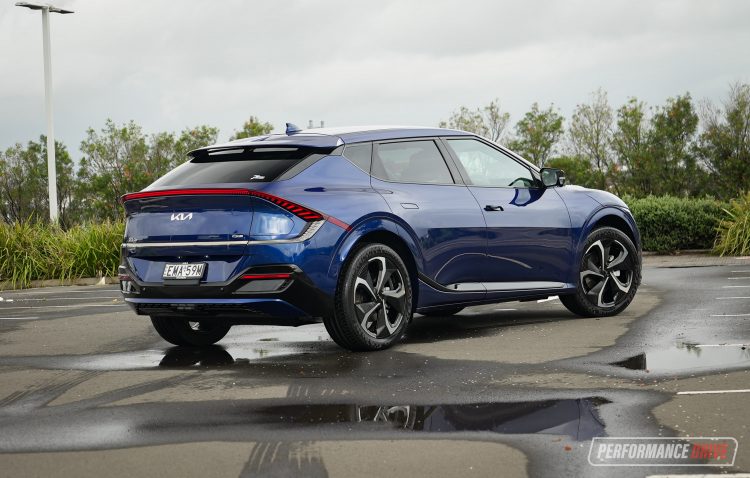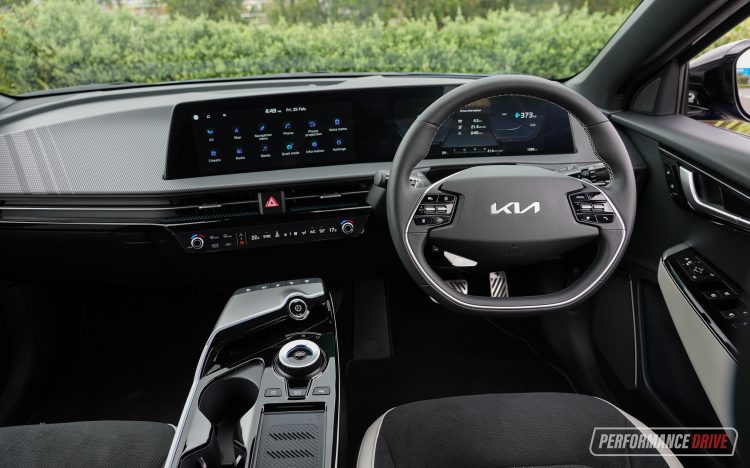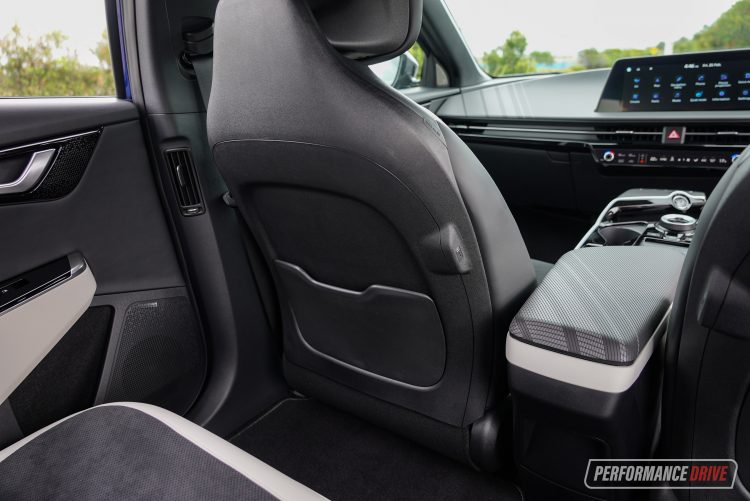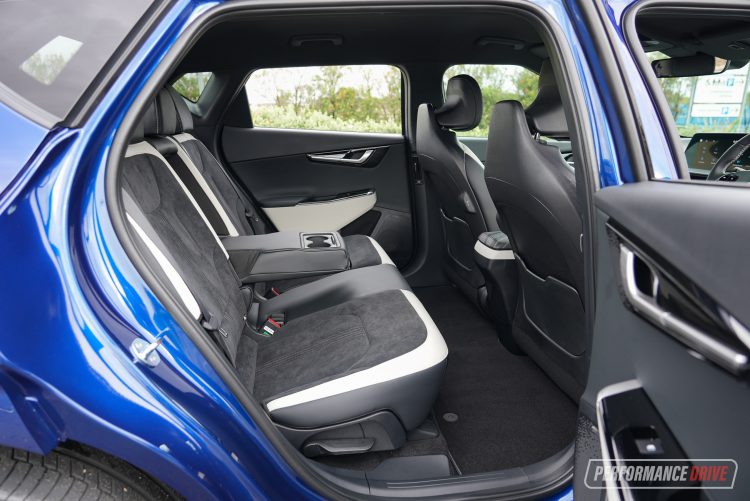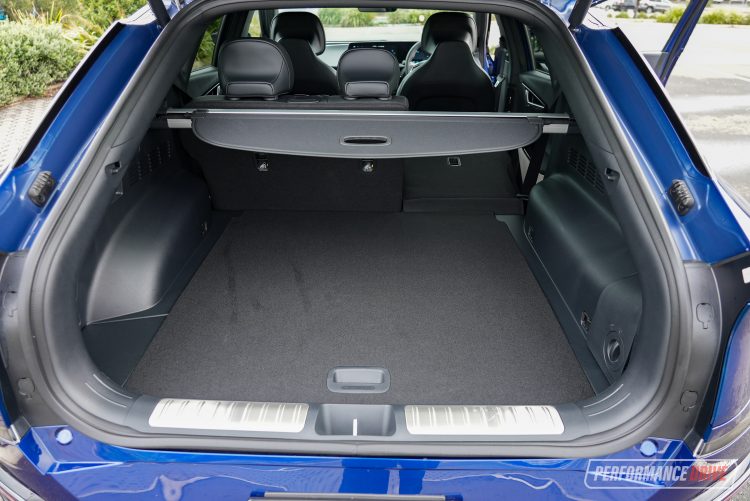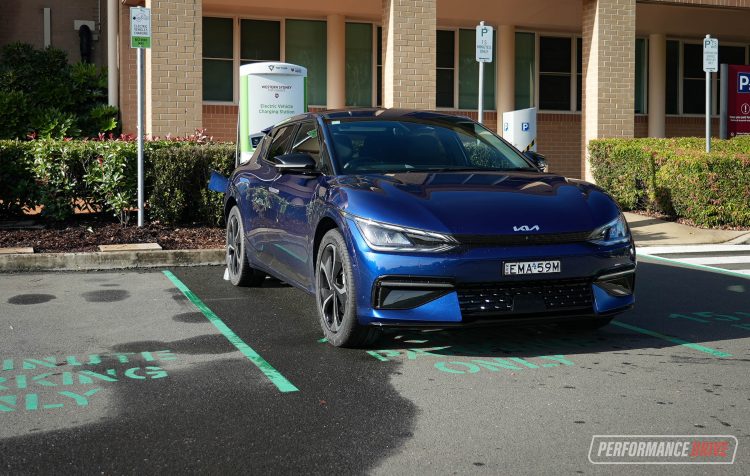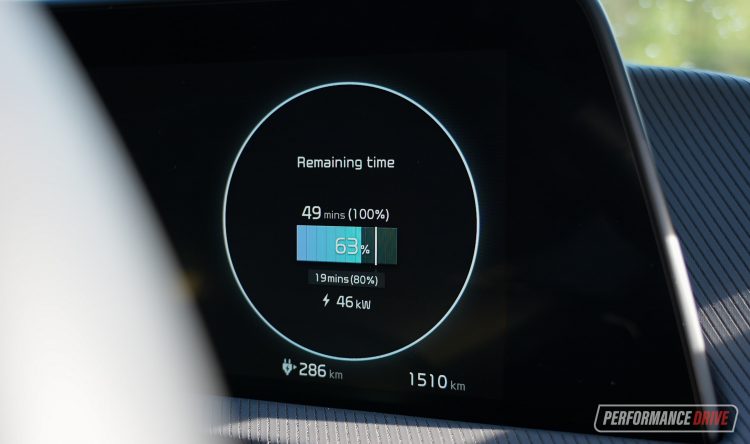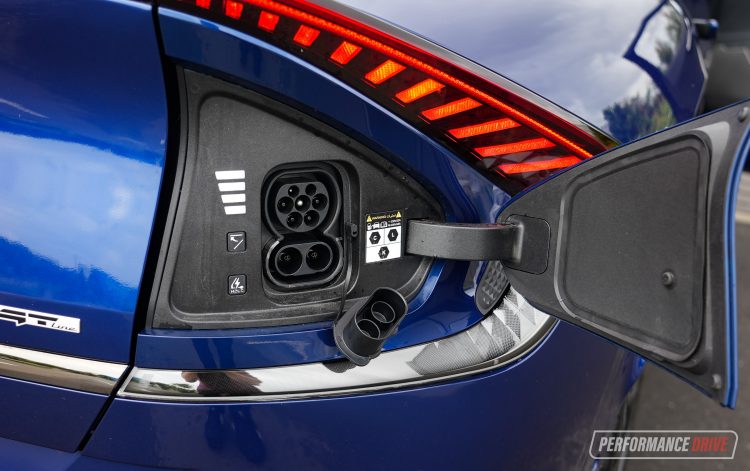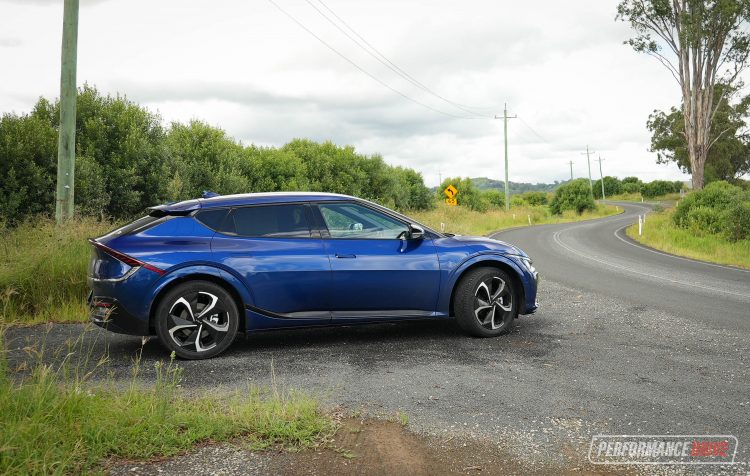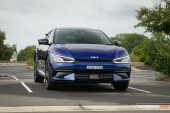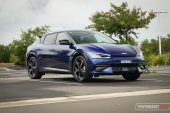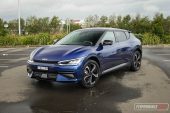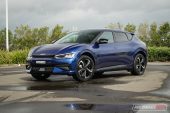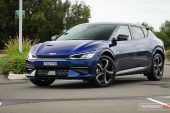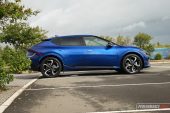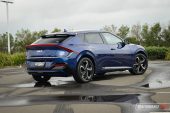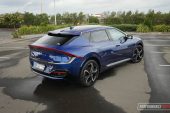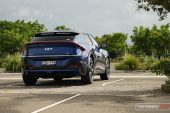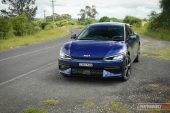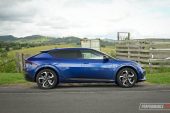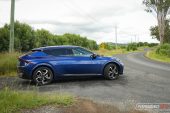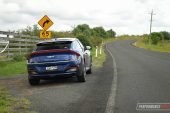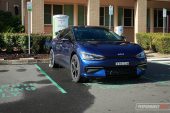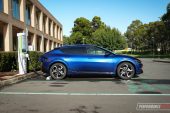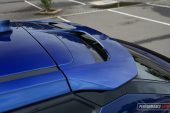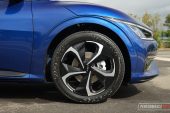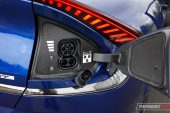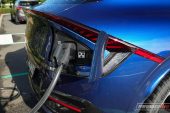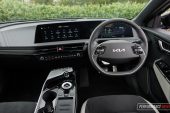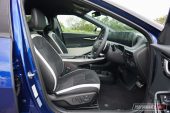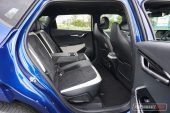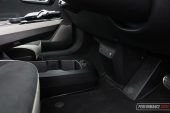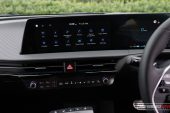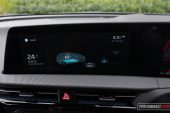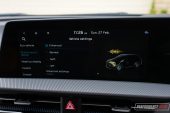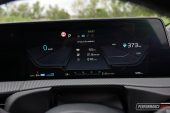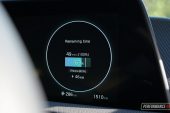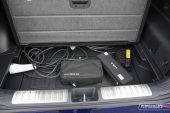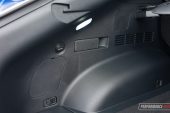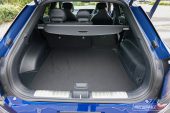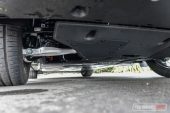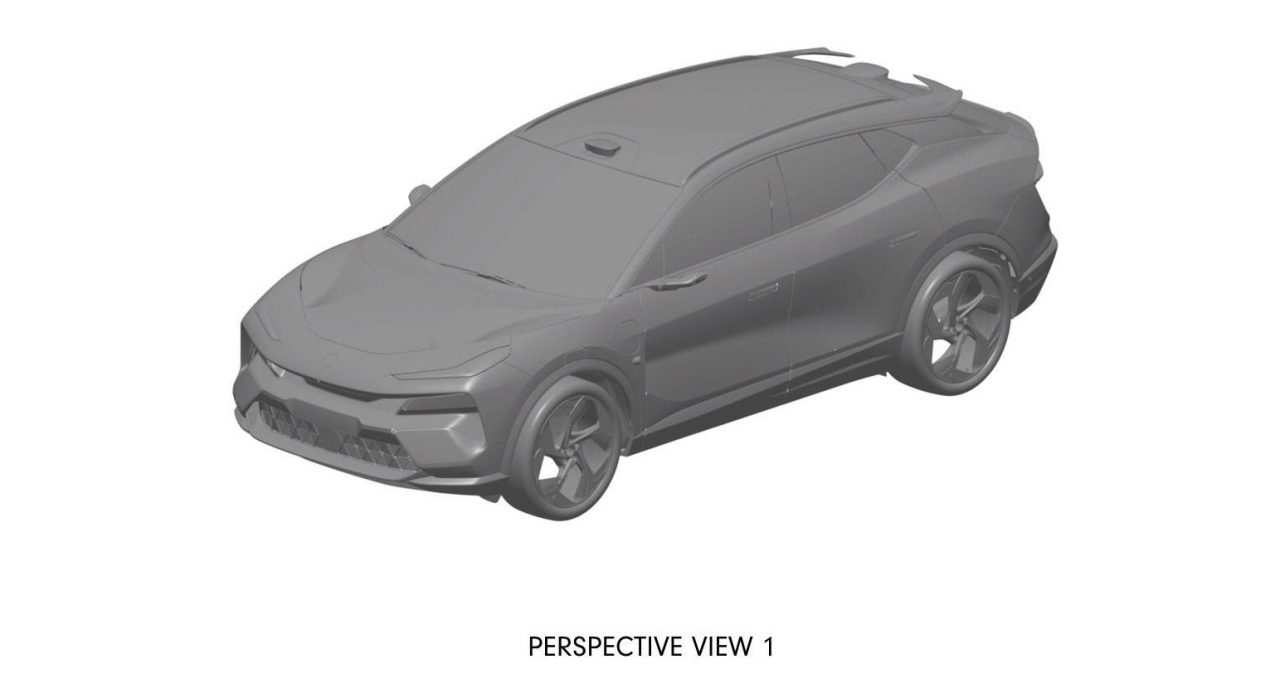Late to the electric vehicle party, Kia has just dropped an all-new dedicated electric large SUV in Australia for 2022. The Kia EV6 is the first of a range of nomenclature EV models that Kia aims to release, topping out with the EV9 in 2023. It is also the first model to use the Korean company’s ‘Electric Global Modular Platform’ (E-GMP) that the Hyundai IONIQ 5 and Genesis GV60 use as well.
For the Aussie market, the EV6 can be had in two grades so far; the EV6 Air in rear-wheel drive only, and the GT-Line available in rear-wheel drive and all-wheel drive. Unfortunately, unless Kia Australia can increase its allocation of 500 units for 2022, waiting times are reported to extend into 2025. Though, the high-performance (430kW) EV6 GT is on its way later in 2022 or early 2023.
The single motor rear-wheel drives produce 168kW of power and 350Nm of torque. It can sprint from 0-100km/h in a claimed 7.3 seconds. Then the dual motor all-wheel drive GT-Line produces a huge 239kW and 605Nm, and reaches 0-100km/h in just 5.2 seconds. Though, its driving range falls to 484km.
The entry-level Air RWD kicks off the price at $67,990 and comes with an impressive driving range of 528km. Stepping up to the RWD GT-Line that we’re testing here retails from $74,990, and the driving range drops to 504km. The top GT-Line AWD price tag is $82,990 (all excluding on-road costs).
2022 Kia EV6 GT-Line – THE SPECS
[column width=”47%” padding=”6%”]Battery: 77.4kWh lithium-ion, 697V
Output: 168kW / 350Nm
Transmission: Single-speed reduction gear
Drive type: Rear-wheel drive
Wheels: F & R: 20×8.0, 255/45
ANCAP: Not tested
Tare weight: 2000kg
Power-to-weight: 11.90:1 (kg:kW)
Official range: 504km
Recharge capacity: DC up to 350kW, AC 10.5kW
Recharge time 10-80%: DC 50kW 73min, DC 350kW 18min
[/column] [column width=”47%” padding=”0″]0-60km/h: 3.72 seconds*
0-100km/h: 7.22 seconds*
60-110km/h: 4.60 seconds*
1/4 mile: 15.39 seconds at 151.4km/h*
Max acceleration: 0.792g
100-0km/h braking: 3.04 seconds at 37.44 metres*
Max deceleration: -1.362g
Decibel at idle (/Enhanced sound): 22/23*
Peak decibel at 60-100km/h: 71/75*
Priced from: $74,990[/column][end_columns]
* Figures as tested by PerformanceDrive on the day. Factory claims may be different
2022 Kia EV6 GT-Line – THE PACKAGE
Up to now, all-electric vehicles tended to look a little ugly as aerodynamics took preference over design. But the Kia EV6 looks suave. In our time with this test vehicle, we had lots of onlookers gawking with curiosity. One even pulled out her phone to snap a few sneaky shots. The front end has a striking angry look with a prominent bonnet line that swoops down. A small grille, flared bonnet contours, a deep lower door indent, and ripples that exaggerate the wheel arches certainly give off a sporty vibe rather than a conservative one.
The door handles tuck away flush with the sheet metal when not in use like a Land Rover or Telsa, helping with aerodynamic efficiency. Not something we’d expect to see from a Kia.
The rear is even more eye-catching with a slanting roof that ends with a sharp upper spoiler. Matching the trend of other new Kia models is one single thin LED taillight across the rear. Large swooping sheet metal under it makes the EV6 look sleek and distinct. Overall, the external design is a real winner to us. As subjective as appearance is, we think the EV6’s external design portrays exactly what the EV6 is trying to be. Except the SUV part – it doesn’t take the shape or height of an SUV at all – ground clearance is just 160mm.
On the inside, the cabin layout takes a new approach to creating a roomy and contemporary space. The centre console suspends above a huge empty space to store things. It’s nothing like what we’ve seen before. All your controls are kept at arm’s reach. It’s amazing how the lack of a floor tunnel can open the space around you. There are hooks on either side of the centre console to hang items on too. Legroom is astoundingly huge in the front and rear, thanks to that lack of a floor tunnel and slim front seats.
The layout of the controls is simplified by using a long and thin touch-screen that toggles between air-con controls and media controls, eliminating the need to have so many buttons. There are also two crisp and high quality 12.3-inch curved displays. Their layouts are clean and quick to grasp.
You certainly get a sense of luxury with brushed metal areas, premium materials and attention to detail, plenty of ambient lighting (with changeable colours) and those high-resolution displays all around you. And this goes right down to the small details; like with the inclusion of lined door pockets, the positive feel of the buttons, and the striped soft-touch dashboard garnish. Though, we’re not sure how smart it is to use this material on the centre armrest. Our example was already starting to build up grime in between the pattern stripes.
Both front seats offer eight-way power adjustments and two-way power lumbar support. Not only are the seats supportive and comfortable, they also look urbane. Our GT-Line spec had artificial black suede midsections with a white leather outer and white stitching. The rear seats also follow the same pattern as the front, but they feel a little on the firmer side to sit in. We love the placement of the two USB-C ports on the sides of the front seats to keep the kids happy with their electronic devices.
An added benefit of doing away with a conventional engine is the room to offer two boots. At the front, the EV6’s bonnet opens to a small 52-litre ‘frunk’ (20L in the AWD), but it doesn’t open and close as smoothly as the rear boot – so you probably won’t use it that often. Otherwise, the real boot offers 480 litres of storage (490 litres in the Air) using the VDA measuring standard.
It’s a long but shallow boot not dissimilar to a sedan. So, it might struggle to fit particularly bulky items. The space opens to 1260 litres with the 60:40 rear seats folded down (1270L in the Air). And you can fold down the seats from pull-tabs in the boot.
In the way of equipment, it is a banquet of a list. Some of the most important technologies include forward, rearward, and post-collision mitigation, lane keeping aid and departure warning, safe exit warning, an augmented reality head-up display, a superb 14-speaker Meridian sound system with sub-woofer, sat-nav with ten years of traffic info and map updates, a wireless phone charger, wired Android Auto and wired Apple CarPlay, dual-zone climate control with driver-only mode to improve driving range, heated and ventilated front seats, selectable driving modes, distance-controlled cruise control, lead vehicle assist, 360-degree cameras, an electric tailgate, and remote smart park assist with parallel and perpendicular parking, to name a few.
Kia has one of the best warranties in Australia, with seven years and unlimited kilometres. You also receive free roadside assistance for one year. Servicing is required every 15,000km or 12 months after the first service, which is three months or 3000km.
2022 Kia EV6 GT-Line – THE DRIVE
As we have explained in other EV reviews, the delivery of power feels very different to a combustion engine. You get an instantaneous surge with no lag. Other luxury EVs on the market have enough power and torque to make that surge almost feel limitless. The EV6 is not as excessive in the amount of thrust it offers, but it certainly gives a thrill. It’s also a calm affair when full throttle is demanded – there is no screaming engine or gear kickbacks to wait for.
With 168kW and 350Nm at the end of your foot, a 0-100km/h speed can be achieved in a claimed 7.3 seconds. Our testing measured it in 7.22 seconds, using a Racelogic Vbox. The official claim is 0.1 second quicker and makes it 8kW more powerful than the RWD Hyundai IONIQ 5. But it doesn’t reach the thrust of the cheaper Tesla Model 3 Standard RWD’s 190kW/375Nm output and 6.1-second 0-100km/h claim. Power comes from a 77.4kWh and 111.2Ah lithium-ion battery.
One of the most important aspects of EVs are how far they will drive you before needing to recharge. The EV6 does reasonably well compared to the competition. Our GT-Line RWD can officially travel 504km. Thankfully, this figure tends to be quite accurate. We also appreciate the clearly marked out remaining range in kilometres and battery percentage, both always on display.
The centre screen has an EV menu with even more detail – including a minimum travel range based on a worst-case driving style scenario and a maximum travel range based on a best-case driving style scenario. Very helpful. We found that driving at freeway speeds are the worst-case scenario for EVs and the EV6; opposite to a conventional engine that generally prefers the highway thanks to multiple gears.
Nonetheless, 504km is a decent distance, and would probably suffice for a significant number of Aussies. The Tesla Model 3 travels 491km and the Hyundai IONIQ 5 travels 451km. When it comes to topping up the juice, an on-board DC fast charger supporting up to 350kW does the trick ultra-fast. In fact, it can charge from 10 to 80 per cent in just 18 minutes. That is coming blissfully close to the time it takes to fill a car with fossil fuel.
Otherwise, a 50kW DC charger will top up from 10 to 80 percent in 73 minutes. We used this option as the 350kW charging station was out of order during our test. It cost us $21.11 to charge from 17 to 93 per cent and it took one hour and 17 minutes.
Of course, there is also the option to charge with the on-board 10.5kW charger. This will take just over 7 hours using an 11kW system. And last resort is a trickle charge on a regular AC 240-volt power point. The charge port is at the rear disguised neatly under the driver’s side taillight, and supports both Type 2 and CCS2 sockets.
A standout in the EV6 is in the operation of the one pedal stop/go function. There are three settings that adjust how much braking force is applied to recharge the battery when the accelerator is released. This can be adjusted instantly using the steering wheel paddle shifters. In other EVs we have driven, when the highest level of braking is used, it caused a jerky ride when travelling under 20km/h. But the Kia EV6 has the sense to know that when the highest level of charging is selected, and when travelling at carpark speeds, to ease off on that braking pressure. After all, not a lot of charge is collected when travelling at less than 20km/h anyway.
Regrettably, there is a bigger issue with EVs here in Australia. The charging network is still in its infancy. During our time with the EV6, we dealt with wait queues, ‘out of order’ charging stations, and simply a lack of them. Our advice would be that purely relying on the charging infrastructure currently out there is just not sufficient for the average city dweller (especially those living in apartment blocks that do not allow EV charging).
Until the charging network matures and expands, you will get the best experience from the EV6 with your own charging setup. Which then locks out approximately one third of Aussies who rent and do not have the freedom to install charging infrastructure in their dwelling.
Like with all Kias, the EV6 has gone through some local suspension tuning. That Aussie tuning sure goes a long way to make it a calming and deluxe drive. It also has an impeccable ability to absorb those nasty road imperfections, and quietly. Add to that, it handles corners with agility and poise. You can really push it around corners and hit the apex, and hold a line right up to the exit point without it feeling insecure. Thanks to that weight, it stays flat and stable longer than you’d expect.
2022 Kia EV6 GT-Line – THE VIDEO
2022 Kia EV6 GT-Line – THE VERDICT
Kia has mastered its first dedicated EV. The EV6 has one of the best driving ranges for its price and enough power to feel exciting. Not only do you get a huge interior, the interior is full of luxury touches and tech that doesn’t overwhelm. And the external design turns heads.
You can’t miss the advantages of owning an EV. But they are only available to drivers with specific lifestyles until the Australian Government pulls its finger out and creates policy that encourages lower emissions and a strong charging network. That should ensure manufacturers do not overlook the Aussie market, too.
[column width=”47%” padding=”6%”]PROS:
– Striking design, inside and out
– Liveable travelling range with accurate remaining kilometres
– Ultra-fast 350kW charging capability
– Outstanding amount of space in the cabin
– Two high-quality curved displays look spectacular[/column] [column width=”47%” padding=”0″]CONS:
– High price tag compared to fossil fuel powered equivalents
– Lacking EV infrastructure in Australia reduces its suitability for some buyers/lifestyles
– Ridiculously long waiting list[/column][end_columns]
As always, if you’re thinking about buying a new car don’t forget to click here to speak with our car buying specialists.

